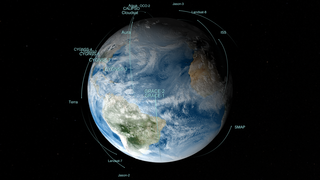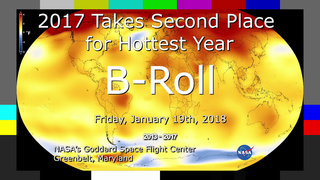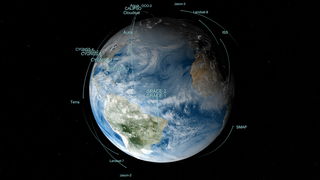Earth
ID: 12586
No planet is better studied than the one we actually live on. NASA's fleet of 26 Earth science spacecraft, supported by aircraft, ships and ground observations, measure aspects of the environment that touch the lives of every person around the world. They study everything from the air we breathe, to rain and snow that provide water for agriculture and communities, to natural disasters such as droughts and floods, to the oceans, which cover 70 percent of Earth’s surface and provide food for many people around the world. Satellites and instruments on the International Space Station circle the whole globe, seeing both where people live and those remote parts of deserts, mountains and the vast oceans that are difficult if not impossible to visit. With instruments in space, scientists can get data for the whole globe in detail that they can't get anywhere else. This visualization shows the NASA fleet in 2017, from low Earth orbit all the way out to the DSCOVR satellite taking in the million-mile view.
NASA's Vantage Point to View Earth
Source Material
Related
Credits
Matthew R. Radcliff (USRA): Lead Producer
Aaron E. Lepsch (ADNET Systems, Inc.): Technical Support
Greg Shirah (NASA/GSFC): Lead Animator
Ernie Wright (USRA): Animator
Aaron E. Lepsch (ADNET Systems, Inc.): Technical Support
Greg Shirah (NASA/GSFC): Lead Animator
Ernie Wright (USRA): Animator
Please give credit for this item to:
NASA's Goddard Space Flight Center
NASA's Goddard Space Flight Center
Short URL to share this page:
https://svs.gsfc.nasa.gov/12586
Missions:
Aqua
Landsat
NPP
Terra
This item is part of this series:
Earth Observing Fleet
Keywords:
SVS >> HDTV
SVS >> Orbit
SVS >> Lagrange Points
SVS >> Earth >> Satellites >> Earth Observing Fleet
NASA Science >> Earth
SVS >> Fleet
https://svs.gsfc.nasa.gov/12586
Missions:
Aqua
Landsat
NPP
Terra
This item is part of this series:
Earth Observing Fleet
Keywords:
SVS >> HDTV
SVS >> Orbit
SVS >> Lagrange Points
SVS >> Earth >> Satellites >> Earth Observing Fleet
NASA Science >> Earth
SVS >> Fleet














